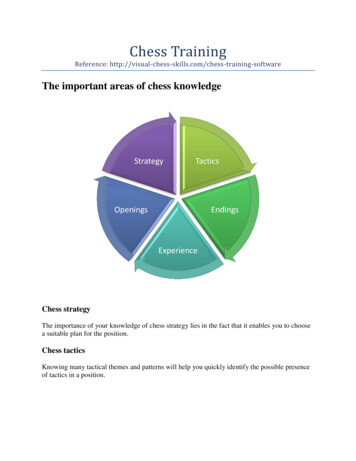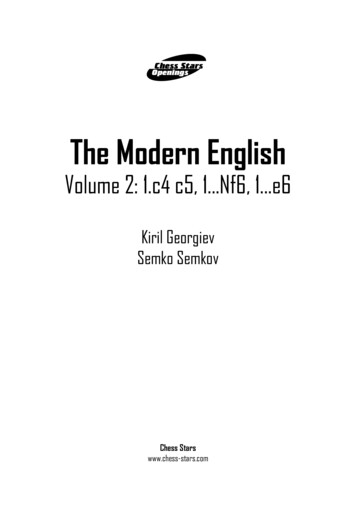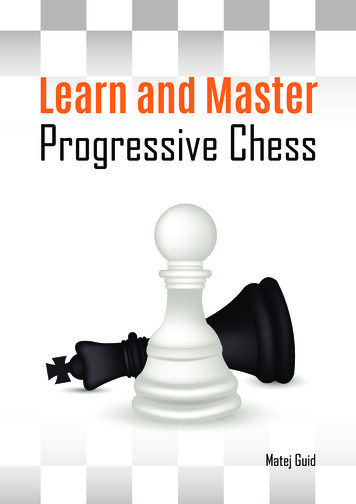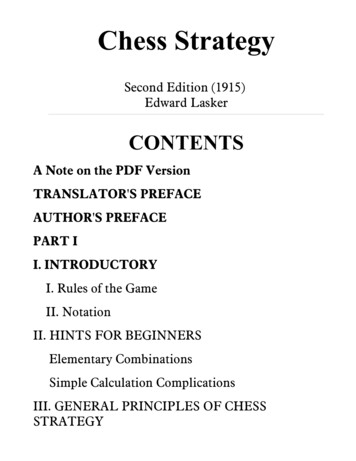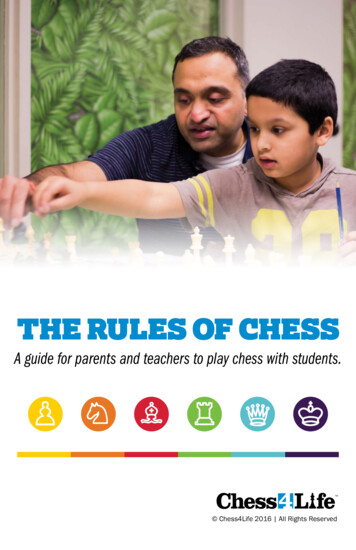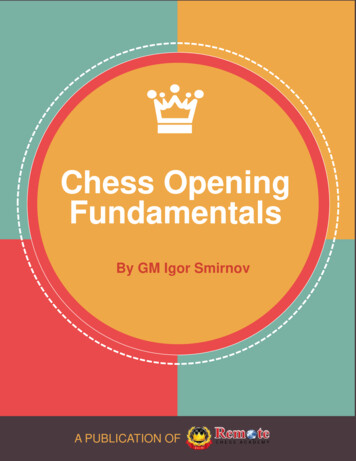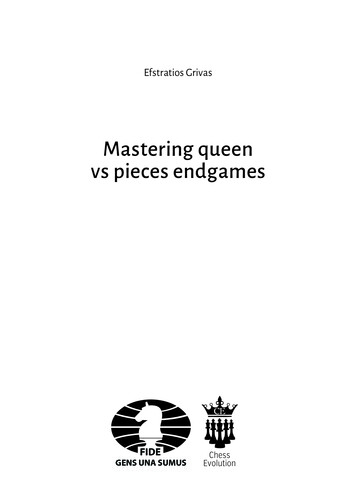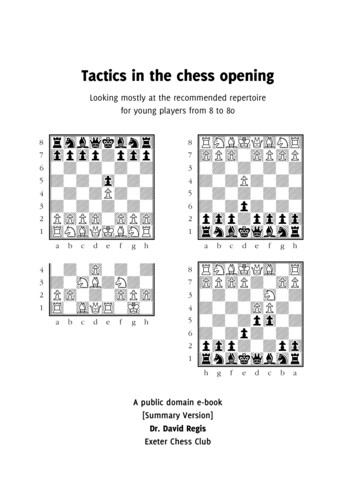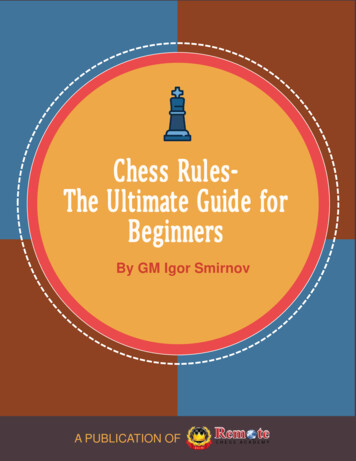
Transcription
Chess RulesThe Ultimate Guide forBeginnersBy GM Igor SmirnovA PUBLICATION OF
ABOUT THE AUTHORGrandmaster Igor SmirnovIgor Smirnov is a chess Grandmaster, coach, and holder of a Master’s degree inpsychology.He’s the founder of the “Remote Chess Academy” company that has helpedthousands of students worldwide to improve their results.GM Smirnov has developed lots of chess video lessons, articles, webinars andtraining courses, including the famous courses “The Grandmaster’s Secrets”,“The Grandmaster’s Positional Understanding”, and “Calculate Till Mate”.2
TABLE OF CONTENTS1.Evolution of chess rules8.Movement of the pieces2.The chessboard9.Special moves3.Symbols of chessmen10.Promoted Pawn4.Arrangements of pieces11.Check and Checkmate5.Nature and objectives12.Draw6.Naming of squares13.Values of chess pieces7.Colour classification14.Three stages of chess3
Chess is the most intelligent game ever invented. It has a lot of things that aresimilar to life. It trains you to use all your resources to the maximum extent.Learning basic chess rules will help you build a strong foundation in chess.Many students do not have clear picture on these rules at their beginningstages.That is why I decided to help beginners with basic chess rules.Chess teaches you administration and to extract work from your subordinates.It is a battle between two monarchs. The king manages the troops. He plansthe operation and executes it.
1Evolution of chess rulesThe rules of chess have evolved much over the centuries, from the earlychess-like games played in India in the 6th century. For much of that time,the rules varied from area to area.The modern rules first took form in Italy during the 13th century, givingmore mobility to pieces that previously had more restricted movement(such as the queen and bishop).Such modified rules entered into an accepted form during the late-15th orearly 16th century.The basic moves of the king, rook, and knight remain unchanged. Pawnsoriginally did not have the option of moving two squares on their first moveand when promoted by reaching the eighth rank, could become a queenonly.5
2The chessboardChess is played on a square board divided into 64 squares (eight-by-eight)of alternating color.No matter what the actual colors of the board, the lighter-colored squaresare called “light” or “white” and the darker-colored squares are called “dark”or “black”.Sixteen White and sixteen Black pieces are placed on the board at thebeginning of the game. The board is placed so that a white square is in eachplayer’s bottom-right corner.Horizontal rows are called ranks and vertical rows are called files.According to FIDE equipment standards, the length of side of a squareshould be twice the length of the diameter of the base of a pawn.6
3Symbols of chess piecesKingQueenKnightRookBishopPawn7
A chess piece, or chessman, is any of the 32 movable objects deployed on achessboard used to play the game of chess. In a standard game of chess,each of the two players begins a game with the following 16 pieces:OneOneTwoTwoTwoEight8
4Arrangements of piecesThis is the starting position of the game9
At the beginning of the game, the pieces are arranged as shown in thediagram: for each side one king, one queen, two rooks, two bishops, twoknights, and eight pawns. The pieces are placed, one on a single square, asfollows:You cannot place more than one piece on a square at any time.X10
5Nature and objectives of the gameThe game of chess is played between two opponents who move their piecesalternately on a square board called a chessboard.The player with the White pieces commences the game. A player is said to‘have the move’ when his opponent’s move has been completed.The object of the game is to trap the opponent’s king so that its escape isnot possible (checkmate). If a player’s king is threatened with capture, it issaid to be in check, and the player must remove the threat of capture onthe next move. If this cannot be done, the king is said to be in checkmate.The objective of each player is to put the opponent’s king under attack insuch a way that the opponent has no legal move. The player who achievesthis goal is said to have checkmated the opponent’s king and to have wonthe game.11
Leaving one’s king under attack, exposing one’s king to attack and also’capturing’ the opponent’s king is not allowed – the opponent whose kinghas been checkmated has lost the game. If the position is such that neitherplayer can possibly achieve a checkmate, the game is drawn.Although the king is the most important piece, it is usually the weakestpiece in the game until a later phase, the endgame.12
6Naming of squaresKeeping a record of chess moves will be very useful in improving yourstandard of chess. It is mandatory in all recognized tournaments, in order tosettle disputes about illegal positions, overstepping time control and makingclaims for a draw by the fifty-move rule or repetition of position.Each square of the chessboard is identified with a unique pair comprising aletter and a number. The vertical files are labelled in small letters “a” to “h”,from White’s left to White’s right. Similarly, the horizontal ranks arenumbered from 1 to 8.Each square of the board, then, is uniquely identified by its file and rank(letter and number). The White queen, for example, starts the game on thesquare d1 and the Black queen on d8.13
The following are the letters used in capitals to represent various pieces.A pawn does not have any specific symbol but is represented by the nameof the square it occupies, i.e. it is not indicated by its first letter butrecognized by the absence of such a letter. Example: the moves are writtene5, d4, a5 – not pe5, pd4, pa5.14
7Colour classificationThere are 64 squares on a chessboard – 32 White squares and 32 Blacksquares.Hence, the rule for colour classification is:i) Odd letter x odd number is a Black square – e.g. a1, c3ii) Even letter x even number is a Black square – e.g. b2, d4iii) Odd letter x even number is a White square – e.g. a2, c4iv) Even letter x odd number is a White square – e.g. b1, d315
8Movement of the chess piecesThe king moves exactly one square horizontally, vertically or diagonallyThe rook moves horizontally or vertically, through any number ofunoccupied squares16
A bishop moves any number of vacant squares in any diagonal direction.The queen moves any number of vacant squares in a horizontal, vertical ordiagonal direction.When making these moves, the bishop, rook or queen may not move overany intervening pieces.17
A knight moves to the nearest square not on the same rank, file or diagonal.(This can be thought of as moving two squares horizontally then one squarevertically, or moving one square horizontally then two squares vertically—i.e. in an “L” pattern.)The knight is not blocked by other pieces: it jumps to the new location.Pawns have the most complex rules of movement:A pawn moves straight forward one square, if that square is vacant. If it hasnot yet made its first move, a pawn also has the option of moving twosquares straight forward, provided both squares are vacant. Pawns cannotmove backwards.18
9Special chess movesen passant captureA pawn attacking a square crossed by an opponent’s pawn which hasadvanced two squares in one move from its original square may capturethis opponent’s pawn as though the latter had been moved only onesquare. This capture is only legal in the following move:This advance is called an ‘en passant ‘capture.19
CastlingThere are two different ways of moving the king: by moving to any adjoiningsquare not attacked by one or more of the opponent’s pieces or by castling.The latter is a move made by the king and either rook of the same colouralong the player’s first rank, counting as a single move of the king andexecuted as follows: the king is transferred from its original square twosquares towards the rook on its original square, then that rook is transferredto the square the king has just crossed.Note: For castling to be legal, the king or rook must not have been movedpreviously.20
10Promoted PawnWe discussed in chapter 8 how pawns have the most complex rules ofmovement. Pawns can’t move backwards, they can only move forward andcapture sideways. What happens when a pawn reaches the farthest possiblesquare?Whenever a pawn (black or white) reaches the last rank, it can promote intoa queen, rook, bishop, or knight. We can see that for white the last rank isthe 8th rank, and for black it is the 1st rank.While this may not happen very often in the early stages in the game, in thelater stages pawn promotions determine the outcomes of games.21
11Check and CheckmateWhat is a check? Check is a condition in chess when a player’s king is underthreat of capture. The player who is in check must remove their king out ofcheck in their next move.There are three ways to remove a check:1. Capture the piece that is giving check.In the given example, we can see Black’s king is in check. Black’s only way toget rid of this check is by capturing the bishop on h7. Because the bishopon h7 is not protected by any piece, this is a legal move.22
2. Moving the king away from checkAs we can see, the bishop is now protected by the knight. Black can’tcapture the bishop; however, black can move his king to the h8 square.3. Blocking the piece giving checkIt is also possible to stop a check without moving the king.In this position, black could move his king to h8 and move away from theline of attack; furthermore, he can place a piece in bishop’s diagonal toprotect his king.23
Now that we’ve discussed the three ways in which you can check youropponent, let’s look at the following position:Black is in check. What are all the possibles moves black can make toremove the threat of capture?Think carefully and after you think all the possible moves, scroll at the end ofthe chapter to see the solution.What happens when a player can’t get out of check?In other words, what if there is no legal move that allows a player to removehimself from check? When this happens, it is considered checkmate and theplayer who is checkmated loses the game.This position is similar to the positions discussed earlier. The difference isthat white can’t capture the bishop or move himself out of bishop’s line ofattack. This means black is checkmated and white wins the game.24
Solution to the problem:There are six ways in which black can get out of check.The king can move to a7 or a8The rook can move to c7The queen can move to c7 or d6The knight can jump to e5.25
12DrawThere isn’t always a winner and a loser in chess. There are several reasonswhy a chess of game may end in a draw:1. Both players agree on a draw.2. Both players have traded enough pieces so that it is impossible for eitherplayer to checkmate the other.3. Either player can declare a draw if the same position is reached threetimes.4. Either player can declare a draw if 50 chess moves (50 white and 50 black)have been made and not a single pawn move or a piece has been captured.5. It is one’s player turn to move, and while he is not in check, he does nothave any legal moves. This is called stalemateLet’s look at a position to understand more what stalemate is.26
We can see that white has no legal moves in this position. We can also seethat black has cornered the king and has an extra queen.If it was white to move, this position would be drawn, because white has nolegal moves. If it was black to move, black could realize any move to avoidstalemate and checkmate white in the future.27
13Relative value of chess piecesBecause every single piece in chess has unique movement, they possessdifferent strengths and weaknesses. For this reason, it is important to knowthe “value” or “points” each piece has. While these points do not give youan absolute tool to evaluate every single position in chess, they help youunderstand which trades are beneficial and which trades you should avoid.Let’s look at the relative value of every single piece:The pawn is worth 1 pointThe bishop is worth 3 pointsThe knight is worth 3 pointsThe rook is worth 5 pointsThe queen is worth 9 pointsBecause whoever checkmates (“captures”) the opponent’s king immediatelywins the game, it is said that the king has infinite value.28
14The Three Stages of the gameA game of chess is divided in three stages:While not every single chess game goes through these three stages (somegames might end in the opening or middle game), It is important torecognize at which stage of the game one is in while playing.Chess is similar to war. You don’t just jump right in battle. You first expandyour territory (move chess pawns), then prepare your forces for battle(develop your pieces), and lastly start fighting. In chess, moving pawns notonly helps you obtain space, but also frees up your pieces to move freely.29
The opening stage is the first phase of the game. This is where both sidesdevelop their forces and “prepare” themselves for the middle game.In chess, developing a piece means to place a piece in a square where it ismore active. At the start of a chess game, all the pieces are behind pawnsand possess limited mobility. When we move, or develop, our pieces, we’reimproving their activity and preparing them for battle.While there is no clear cut move that defines the end of the opening andthe start of the middle game, it is usually considered middle game afterboth players have castled and developed their queens.Here is an example of a game in its opening stage:30
Nowadays, thanks to the analysis of computers and many strong players,there exist a vast amount of opening theory. In other words, after millions ofchess games, players have realized which opening moves score better andwhich ones are less powerful.At the highest level, players memorize hundreds of chess openingvariations. This allows players to obtain the upper hand and make 1
Chess teaches you administration and to extract work from your subordinates. It is a battle between two monarchs. The king manages the troops. He plans the operation and executes it. Evolution of chess rules The rules of chess have evolved much over the centuries, from the early chess-like games played in India in the 6th century. For much of that time, the rules varied from area to area. The .
